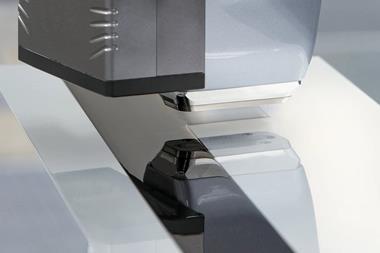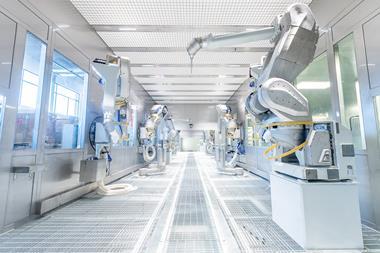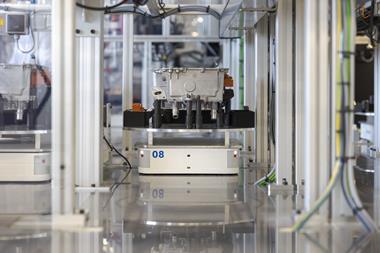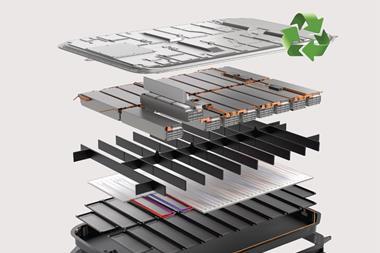 New software from Dürr can help paintshops utilise the latest Industrial Internet of Things technology to collect, evaluate and visualise robot and process data
New software from Dürr can help paintshops utilise the latest Industrial Internet of Things technology to collect, evaluate and visualise robot and process data
As paintshops become increasingly transparent, Dürr Systems has developed its EcoScreen Equipment Analytics software in order to collect, evaluate and visualise robot and process data. This allows processes to become more efficient, eliminates faults, supports maintenance work and ensures product quality. This IIoT (Industrial Internet of Things) solution is another application within the company’s digital@Dürr strategy.
The software enables users to see exactly what is happening in the painting cell and assess the condition of the robots, atomisers, metering pumps, and colour changing technology. To be able to look under the hood of automatic painting technology during operation, Dürr has developed software that collects and analyses all data belonging to the painting robots in a cell.
The basic modules of the new EcoScreen Equipment Analytics software comprise a data recorder, a database, and a visualisation for graphic representation and analysis of the results on the station control computer. These are complemented by additional modules for automated analysis, and IoT connectors with higher-level systems. The new software is integrated into the programming and parameterisation software (EcoScreen 3D-OnSite4), installed as standard for all Dürr application robots.
The transparent robot arm
In the standard software scope, all relevant signals, as well as results of the individual painting robots, are collected first: the program accesses the sensors and actuators installed in the Dürr painting robots for this. The application technology housed on the front robot arm continuously supplies data from the pressure sensors and pressure regulators, as well as the metering pumps and colour valves.
Main needles, turbine speed, shaping air and air heaters from the electrostatic high-speed rotary atomisers are also connected to the data recorder. In addition, the software records the positions, torques and temperatures of the painting and handling robots’ individual axes, plus the positions of the bodies. This is done by collecting data from the conveyor technology.
The data is compared with events from the painting cells for each individual robot. This can be the start and end time of painting, the fixed positions of the robots, the operating mode and the robot status. Production data for the individual bodies, such as type and colour code, are also saved. All errors and warnings from the painting process are also collected.
Visual representation creates transparency
“With the help of the Visual Analytics module we can precisely trace the data from the previous weeks with millisecond accuracy,” explains Dr. Hans Schumacher, president and CEO of Dürr Systems AG. “The detailed information helps us to identify and eliminate faults quickly. The cross-comparisons of different robots improve root cause analyses and help the plant operator to boost plant availability, increase the first-run rate and improve the overall process sequence.”
This process creates transparency. For example, the signals collected from the metering pump – together with flow rates, pressure regulators and main needles of the atomisers – can be displayed simultaneously on the control computer and correlations can be defined. The software can display these process signals in a 3D view, together with the trajectories travelled by the robots and the exact position of the body, and perform a comparison. By superimposing the signal curves, EcoScreen Equipment Analytics can also compare bodies by type and colour.
Calculating the ideal plant condition
The additional Streaming Analytics module goes one step further, analysing the data in real time. Using algorithms, it calculates patterns and correlations that describe the ideal plant condition from the data collected. Even the smallest anomalies, both within the plant and in the process, are automatically identified. Employees can initiate corresponding service measures straightaway and get to the bottom of the deviation before the body even leaves the paint booth.
Streaming Analytics provides the plant operator with easy-to-use graphic interfaces that do not require any programming expertise to create analysis models. For this, Dürr has developed a Model Editor that provides the user with a library of analysis modules. These can also be individually combined into new models (e.g. a model for monitoring the painting pressure during application).
The data is displayed graphically on the screen and the operator can see that all values are within tolerance. With Streaming Analytics, the expert can create an analysis model that automatically determines anomalies, such as air bubbles in the paint, from the characteristics of the signal curve. These possible applications make the Streaming Analytics solution a powerful tool, since the software automates the plant operators’ process knowledge using online analyses.
Integration of machine learning in the future
“In parallel with Streaming Analytics, Dürr is developing further modules for batch analytics applications that work on the basis of artificial neural networks. The software learns the optimal process condition fully automatically and registers every deviation. This means that the software will solve problems itself in the future through machine learning,” explains Dr. Schumacher. “If the self-learning modules detect trends, problems in the equipment can even be identified in advance by specifying a forecast of the event time.”
A number of car manufacturers have been using the EcoScreen Equipment Analytics software since the beginning of 2018. The additional Streaming Analytics module, based on real-time data, will be used for the first time in a complete production line from the fourth quarter of this year. The Batch Analytics module, which uses artificial intelligence, is currently in the trial phase with a first customer.
Dürr designs highly flexible assembly layout for the new Lamborghini Urus
Dürr has been responsible for the installation of the assembly lines, and integration and optimisation of innovative technologies and processes, for the manufacture of the new Lamborghini Urus SUV. The production process is characterised by highly flexible assembly lines with newly developed AGVs (Automated Guided Vehicles) and especially ergonomic workstations.
Lamborghini took just 18 months to modernise the long-established plant at its headquarters in Sant’Agata Bolognese during ongoing production. The space doubled from 80,000 sq.m to 160,000 sq.m, with the overall capacity increased to 7,000 vehicles annually.
Dürr was responsible for developing new production lines for complete vehicle assembly, based on a forward-looking layout in which each area can be used flexibly. This allows the line configuration to be modified at any time following installation; in other words, it remains adaptable to changing requirements.
The conveying system with AGVs, specifically developed by Dürr for the Urus, guarantees a high degree of flexibility. The AGVs move individual components and bodies separately, instead of one after another in a linear conveyor system. They also run without rails, are freely programmable like robots, and can be controlled flexibly. This means future model series can also be manufactured on existing lines, since they can be changed over quickly in order to be appropriate to new market scenarios and varied production requirements. The AGVs at Lamborghini come in three different sizes and are suitable for line feeding tasks, the processes in the main line, and for subassembly and powertrain operations.
In addition to the AGVs, Dürr installed further technologies that also meet the most demanding standards for ergonomics in the workplace. These include loading carriers (body on AGV), unloading devices (car from AGV), rotating and vertical adjustable carriers for body transport and lifting, as well as slat conveyors with a lifting table for moving the vehicle into an ergonomic position.































